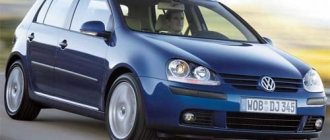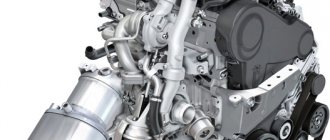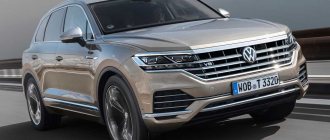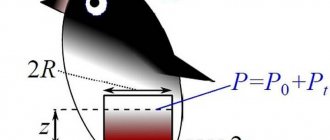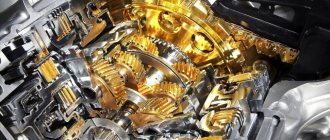The famous and equally popular hatchback all over the world with a monocoque all-metal body, the Volkswagen Golf 2, appeared back in 1983. And 6 years later, when the body was relabeled, this truly people's car began to be called VW Golf II (1G). Its difference from its predecessor is not so great: the body has become more spacious, and the choice of engines has become wider.
Now the Golf 2 is equipped with both diesel GTD (with a volume of 1.6 l), and DOHC (16 valves, volume of 1.8 l), and even the forced G60 (8 cylinders, universal adaptation for all-wheel drive and front-wheel drive systems).
Volkswagen Golf 2 and its brothers
Soon the already rich line of production models was replenished with exclusive, collectible modifications. In particular, this is the VW Golf II (G60) Limited, with Syncro all-wheel drive and a sports gearbox. The total circulation was only 71 units, and they were produced with a gasoline engine (1.8 l) with a mechanical supercharger.
Thanks to this compressor, the power of the Volkswagen Golf 2 increased to 160 hp, while the GTI versions with two-liter engines could only produce 139 “horses”. Production of the G60 lasted only about a year and a half, and their limited supply led to unprecedented demand for these models.
The next modification of the Golf 2 is no less interesting than its predecessors: a car of the already recognized golf class suddenly appears in the guise of a neat SUV. The new version was called Golf II Country, and it was almost a full-fledged SUV - an all-wheel drive car with a traditional “appearance” for production VWs.
The design, however, is completely original. It looks like Golf 2, but only slightly raised and with a spar frame, used in real out-roads. What Country also has in common with true “rogues” is that it has the same ground clearance and reduction gear.
As with the G60, the Golf II Country was a limited edition, which, in fact, made it the most expensive of all versions of the Golf 2. They say that any copy of the Country (if it is in perfect condition) costs the same as a new Golf 4.
Overhaul of KR engine on Golf 2
To begin with, I would like to remind you what all the cheese collection is for. I decided to bring the Volkswagen Golf 2 GTI into divine shape. At the time of purchase, the engine had already been changed three times (as far as I know) under the hood, and all that was left of its former greatness was the GTI nameplate on the back of the car. It was decided to buy a KR engine for disassembly (136-139 hp). Of course, I guessed that it would not be ideal, and to begin with we just wanted to change all the gaskets and seals.
We begin to disassemble, and it immediately turns out that the cooling pump died in terrible agony; during the disassembly process, 5 bolts broke off (the Germans, “bastards,” even used to make bolts very well - when drilling each bolt, they had to sharpen the drill 2-3 times). We get to the block and it turns out that it is after the second repair, there are scuffs on it, the piston, as it seemed to us, is in normal condition. It should be noted that the KR block is a rather rare item for our region. If I say that I found this block in two days in the standard (i.e. there was not a single boring) - it’s the same as going for mushrooms in winter and collecting a bucket of honey mushrooms. I ordered spare parts from St. Petersburg, three weeks later I was at the transport company with two boxes of hardware.
During these three weeks, a new block was bored out, the elbow and the hole for the shaft, as well as the cylinder head, were ground. During assembly, it turned out that one of the four pistons had burst, and we did not notice this due to carbon deposits. And when they started assembling, they cleaned all the parts and saw a huge crack under the carbon deposits. Damn, ordering parts again is a lot of money and a waste of time, since buying in Yekaterinburg is insanely expensive.
In my opinion, the piston is a blank, there are no high requirements for it, so I took a cheaper Porsche from Autowelt. But what I didn’t skimp on and don’t recommend to you is on piston rings and liners; I took Kolbenschmidt. The whole place cost 15,000 rubles and 2 weeks of waiting.
It seems like all the spare parts are there, everything is ready, but the mechanic goes on vacation and goes to the Dyatlov Pass for three weeks. During this time, of course, I bought some other spare parts, so it was not possible to take everything into account. Finally, it was time to assemble the engine.
Now everything was going without any hitches until the moment when we started assembling the cylinder head. It turned out that one half of the cracker was not from our machine, i.e. when previous highly qualified specialists climbed into it, they apparently lost one half and instead took the left one, sharpened it, tapped it and stuck it in. Immediately standing next to the disassembled engine, it turned out that the cracks on this engine would take at least two and a half weeks. Nothing from the Taz suits, but they told me that it does from a Mercedes - 50 rubles and two days of waiting. Three days later we continued. There were no more special nuances, everything was normal. We were worried about the cylinder head bolts from Febi (Chinese), but they withstood a high tightening torque - we can take them. Since the engine will be transferred to January, we immediately bought plugs and o-rings for them and the sensors.
Febi 05280 Water cooling pipe plug
Hans Pries 108 647 015 O-ring
The engine is now assembled. Here's what it looks like with the valve cover assembly painted.
The story of Golf 2 is not over
Production of the Volkswagen Golf 2 continued until 1992 - the latest models date back to December, although for some time the “second” Golf was produced in parallel with the new version - Golf III. And for VW management, such a step was truly economically justified, since the demand for the “kopeck piece” has not fallen at all.
Perhaps the wrong word is “didn’t fall”: many of the domestic car enthusiasts, who know a lot about good and reliable cars, still prefer the well-proven Golf 2 to the next versions of the Volkswagen Golf - 3, 4, and even the ultra-modern “fifth”.
AutoXS.ru - Auto Encyclopedia
- 12-09-2011, 16:14
- Car Directory (all models) / Volkswagen
- Author: VexterXS
Volkswagen Golf II 1983-1992 (“Volkswagen Golf”, VW Golf II) is the second generation of one of the most popular 3- and 5-door hatchbacks. 6,300,987 cars with various configurations rolled off the assembly line. Golf II was produced not only in factories in Germany, but also in France, the Netherlands, Great Britain, Spain, Austria, Switzerland, Finland, Japan and the USA. There is an SUV version - Golf Country, numbering more than 7 thousand copies. There are versions in a convertible body.
Starting in September 1983, the Golf II was produced with a Pierburg/Solex carburetor, but already in January 1984 a GTI modification with an injection engine appeared. The 1.8-liter engines were equipped with mechanical fuel injection systems K-Jetronic (German) and Mono-Jetronic (German), a system of relatively simple structure with continuous fuel injection (electronics were already used in KE-Jetronic and Mono-Jetronic), as well as developed actually VW injection systems Digijet (German) and Digifant (English) for engines with a volume of 1.3 and 1.8 liters, respectively.
Since August 1983, the Golf 2 began to be equipped with naturally aspirated (JP) and turbocharged (JR) 1.6 liter diesel engines with power ranging from 54 and 70 hp. respectively. Since August 1989, two more turbodiesel options have also appeared on the Golf 2: 1V - eco-diesel, equipped with a catalytic converter, with a power of 60 hp. and SB - the most powerful of all - 80 hp. The SB had increased boost pressure and installed an under-hood charge air cooler - an intercooler. Most diesel engines were equipped with Bosch fuel equipment, including a single-piston distribution injection pump (high pressure fuel pump) and injectors. All diesel engines installed on the Golf 2 were swirl chamber engines and were distinguished by their reliability, simplicity of design and fuel efficiency. Consumption per 100 km fluctuates around 6 liters.
The three zzz symbols in the VIN of the Volkswagen Golf II body do not indicate galvanization of the body. It is worth noting that the front grille of various modifications (GTi, G60, Fire and Ice, Carat and many others) has four headlights instead of two. Initially, this was an option that the buyer could order; later, additional headlights were also included in certain trim levels. In the American version of the Golf, instead of round front headlights, there are two square headlights, or rectangular ones, like the VW Jetta model. Every year, designers made minor cosmetic changes, for example, on newer models there are wider moldings, plastic trim on the wheel arches, plastic sills, and the lines of the front grille have become larger. The model underwent the most significant restyling in 1987, and from August 1987, cars of the 1988 model year began to go on sale, which were distinguished primarily by a smaller number of horizontal ribs of the radiator grille, solid front door glass and, accordingly, a different position of the exterior mirrors (now installed at the front edge of the doors). At the same time, instead of glued moldings, they began to be installed on pistons, and the graphics of nameplates with the name of the model changed. In addition to external changes, the purely technical part of the car also underwent serious modernization, for example, changes affected the front suspension and electrical equipment. Starting in '90, sales of VW Golfs with voluminous bumpers began. Since 1988, all-wheel drive Syncro modifications have been produced.
Special mention should be made of the modifications of the Golf that contributed to its reputation as a “hot hatchback”. Starting in January 1984, a GTI modification with an 8-valve engine producing 112 hp was produced; in 1985, the range was expanded by the legendary GTI 16V (139 hp), which to this day is considered the best modification of the Golf GTI of all time. Around the same time, versions with catalysts appeared, their powers are 107 and 129 hp. respectively. In the late 80s, VW experimented with mechanical supercharging. As a result, the G60 supercharged engine (160 hp) also appears under the hood of the Golf. Almost simultaneously, an all-wheel drive version of the G60 Syncro is being released. And to commemorate the rally victories, VW Golf has prepared a limited edition of 5,000 Golf Rally units, technically identical to the G60 Syncro, but with extended wheel arches, different front lighting, radiator grille and bumpers. Finally, the Golf II line-up is completed by the Golf Limited, prepared by VW Motorsport, with a 1.8-liter engine and 210 hp. with G60 supercharger and 16-valve cylinder head. The Golf Country model stands somewhat apart - an almost independent model in which the body and Golf Syncro units are mounted on a frame, thanks to which the car has impressive ground clearance, while, like Syncro, it has a viscous coupling in the rear axle drive, which ensures automatic connection of the rear wheels when the front ones slip. This modification was assembled at the Steyr plant in Graz (Austria), where the Mercedes-Benz G-Class was also produced. Due to the high price, the model did not find wide demand; only a little more than 7,000 units were produced.
Of course, the list of standard and optional equipment has expanded over the years. Thus, the Golf package could include automatic transmission, power steering, air conditioning, alloy wheels, a sliding sunroof with manual or electric drive, electric windows, mirrors, heated mirrors, an on-board computer (brand designation MFA), central locking, makeup mirror illumination, headlight washers, cruise control, fog lights, additional high beam lights, a fully electronic instrument panel, seats with advanced lateral support from VAG Sport or Recaro, the latter could be electrically adjusted, heated seats, velor or leather upholstery, of course, various options for audio systems, capacities for small things in the cabin. The variety was complemented by numerous interior trim and exterior color options. In 1992, the model gave way to the Golf III.
Interesting…
Americans are accustomed to calling the VW Golf the Rabbit, so the Volkswagen concern began producing this model under the name VW Rabbit.
Video review of Volkswagen Golf 2 (1983 - 1992):
Main technical characteristics:
| Model | Volkswagen Golf II |
| Year(s) of issue | 1983 - 1992 |
| Body type | Hatchback, sedan |
| Engine | Gasoline: 1.0, 1.3, 1.6, 1.8, 2.0 (carburetor or injection); Diesel: 1.6; |
| Power | Gasoline: 45 - 210 hp. ; Diesel: 50 - 80 hp |
| Transmission | 3-speed automatic; 4 and 5 speed manual |
| Suspension | Front suspension: Independent suspension with McPherson struts, lower wishbones and stabilizer (GT and GTD only); Rear suspension (regular version): Swivel beam axle with rubber track bearing and spacers; Rear suspension (Golf II syncro, Country, GTI and G60): Axle with swivel beam with rubber bearings for track correction, spring struts and stabilizer |
| Brakes | Disc front, drum rear |
| Max. speed | Petrol: 151 - 220 km/h; Diesel: 145 – 169 km/h |
| Acceleration to 100 km/h | Gasoline: 17.0 - 7.4 sec; Diesel: 23.0 - 14.5 sec |
| Additional Information | Fuel tank volume: 55 l., trunk volume: 345 l. (sedan), 368 l. (hatchback) |
Golf 2: still on the crest of popularity
And this is understandable: the functionality of this family car is simply unrivaled. For example, despite the presence of a fifth door, the volume of the luggage compartment can be increased even more by folding the rear seat in half a minute.
The steering is comfortable and responsive, rack-and-pinion type (there are also power-assisted versions), and the dual-circuit braking system is hydraulically driven and equipped with a vacuum booster.
But the main thing is a completely hassle-free repair. You can easily find any spare part for the Golf 2, and you can install any of the range of engines (volume from 1.3 to 1.8 liters), be it petrol, diesel or turbocharged.

